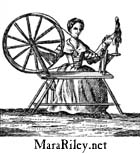| "Gowns weren't worn by middle-class (or poor) women," and "gowns are more dangerous around fires." | |
|
The term 'gown' has come to mean something fancy; however, in
the 18th century, it meant 'dress'. The term applied to anything
from the fancy silk ballgown that most people think of when they year
the term to what would have been referred to in the early 20th century
as a 'housedress' made from common, utilitarian fabrics such as wool,
linen, or linsey-woolsey.
As has been amply documented, gowns are more common than jackets in 18th c. colonial women's inventories . There is plenty of pictoral documentation showing middle-class and working-class women wearing gowns to back up the evidence from the inventories. Middle-class women could have had their gowns made for them by a local mantua-maker, or they could make them at home with the help of a neighbor or relative. Until the middle of the 20th century it was not uncommon for women (we're talking middle-class, here, not wealthy) to go to the local dressmaker to have clothes made, which they would expect to wear for a number of years, whereas now we buy clothes off the rack and throw them out in a year or two. And surviving gowns do show signs of being worn, the fabric being reused or remade into a newer style as fashions changed. Runaways in the Pennsylvania Gazette and other sources wore gowns made of cotton, linen, linsey-woolsey, wool, or silk. They could have acquired this clothing in several ways. Servants routinely received their employers' old clothes as part of their wages, so a silk gown on a servant would not have been unusual. A servant could also have purchased a gown second-hand on the used clothing market. So, folks, gowns were common, and are perfectly appropriate for women doing any 18th century impression, low or high! Just pay attention to the materials you're using, the fashion of the gown, and the condition of the fabric. (I have a fantasy about sewing a silk gown in a mid-18th century style, then distressing the heck out of it -- sun fading, patches, worn spots -- and wearing it to events. But I fear the subtleties would be lost on other reenactors. My current linen gown looks worn -- it has some faded spots, it's wrinkled, and the sewing is coming undone from one or two seams. Yet, what reaction do I get when I wear this tatty old rag? "Wow, you must be portraying a wealthy woman!" THINK, people, THINK! LOOK at what I'm wearing and the condition it's in -- and my worn-out shoes, my stained tow apron, the WHOLE PICTURE! GRRR.) I sometimes think that part of the reaction against gowns in reenacting is that they're something new and different (though this is changing, as more women wear them), and there's a sort of pack mentality that labels anything different as 'wrong' (see below, on the "fire" myth). Now, questioning is good -- people should be able to document what they wear. But in the case of gowns, it is well-documented that poor women wore them -- yet that documentation counts for nothing in the eyes of some reenactors, who may feel that their own impression is threatened if anyone in the group does something different. One of many runaway ads describing a servant wearing a gown: Virginia Gazette The "gowns are more dangerous around fires" myth is a new one to me. I think it arose from a conversation on a reenacting list where someone asked whether the front edges of one's gown might flap loosely into the flames. I also think the person promulgating this myth may have been jealous that the person she was talking to was making a gown, and came up with this excuse as a sort of defense, to try to stop the other woman from wearing something 'different.' In my experience, gowns are NOT a problem around fires -- I always wear an apron, which keeps the fabric nicely under control. I usually wear a linen apron, and have never had a problem with sparks from the fire etc., but if you are concerned about sparks, a wool apron is a good idea -- when sparks land on wool, they smolder, rather than burning quickly, giving you time to react. Also, ALWAYS have a water-bucket around the fire, for safety. A fire extinguisher is also a good idea -- they can be concealed in a camp cooking chest or stowed somewhere else convenient, so long as everyone in camp is alerted to its location. |
|
|
|
|
|
|
|
